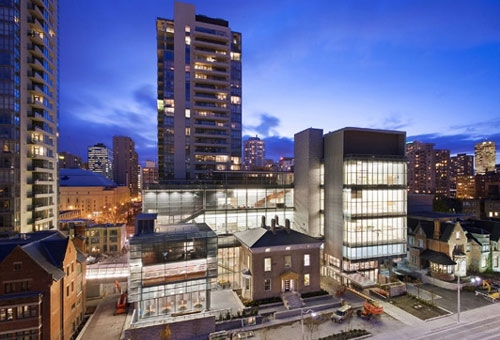Top 10 of 2006: KPMB
The work of this firm triggers new optimism in an architecturally ordinary city like Toronto, writes LISA ROCHON.
LISA ROCHON Tuesday, December 19, 2006
Toronto, the malleable, -- oh, ye burgeoning metropolis of thearrivistes and the just arrived -- is being thankfully converted: from a city of mostly mediocrity to a place of occasional astonishment. Three buildings, all of them by Kuwabara Payne McKenna Blumberg Architects(photo), amazed me this year: the Young Centre for Performing Arts, the Gardiner Museum and Canada's National Ballet School. All three express a joyous belief in the city.
Here are three cultural institutions with an undated shelf life, where we want to return for the exhibitions or performances as much as for the architecture. Arrivals are always crucial moments for the KPMB work, as much as the views from inside. Because of the generous stretch of the stairs leading to the entrance of the Gardiner, because of the beguiling sculpture courtyard in front of the National Ballet School, because of the Young Centre's exuberant canopy thrust over the cobblestones at the Distillery District, your senses are alerted and the pace slows down.
KPMB's work interrupts the way we travel, blindly, through the uninterrupted ordinariness of Toronto.
When they first came together, the four partners -- Bruce Kuwabara, Thomas Payne, Marianne McKenna and Shirley Blumberg -- emerged from the singular, urban teachings of American architect Barton Myers. He left Toronto in 1987 to return to the United States, leaving their minds and hands invested with the robust forms of his mentors Louis Kahn -- the need to make something important of windows by expressing them in wood -- and the fine, nearly obsessive detail work of designer Charles Eames. Canadian winters were harsh, summers were too short, so the need was urgent to create light-filled, transparent lobbies and inner collectors for people paralyzed with cold. Lessons from Woodsworth College (1991) at University of Toronto, a pivotal KPMB project, are still being repeated among students of architecture: It established KPMB as architects who could produce artful compositions of disparate buildings and unify them under decisive, warm-to-the-touch contemporary architecture.
Not long ago, it was possible to chide KPMB for producing careful, even formulaic buildings, for wanting to simply fit in, to make invisible architecture. But the work of the last year displays a sumptuous confidence in what architecture can do and how it can trigger new optimism for the city. In that complex urban development for theNational Ballet School's Jarvis campus (photo), under the tireless management of then-director Robert Sirman, KPMB combined forces with Goldsmith Borgal and Company Architects to create an effortless dance of two historic buildings wrapped by glass volumes housing new ballet studios, a library and cafeteria. Two condominium towers on the tight downtown site helped to pay for the development, allowing the National Ballet School to be noticed around the world as one of the most enlightened and progressive dance institutions. To see young dancers working at the barre, their figures bending and turning against the taut glass curtain wall provides one of the city's rare exhilarations.
For a city on alert for death-defying architecture, in which Daniel Libeskind at the Royal Ontario Museum has produced walls angled as sharply as black-diamond ski hills, there is an exquisite counterpoint being produced by the KPMB partners and their nimble-minded project architects.
Architecture can be contemporary and restful. It can be as cool as the white oak used in the Gardiner Museum, but it can also be earthy and grounding like the Young Centre, where a new atrium of massive wooden timbers connects two historic tank houses, giving an intimate theatre and rehearsal space to Soulpepper Theatre Company and drama students from George Brown College.
Twenty years ago, when the partners put out their shingle, they were filled with social aspirations for architecture. Their maxim was to produce excellence of even small jobs such as the interior design of men's boutiques. This year, the firm has completed or is currently designing five of the major cultural renaissance projects in Toronto, including the highly anticipated Festival Centre and Tower for the Toronto International Film Festival Group at King and John Streets, which will energize an entire city block, and the Royal Conservatory of Music's Telus Centre for Performance and Learning, a work of inspired connections between old architecture and new. In 2006, the omnipresent Bruce Kuwabara won the Royal Architectural Institute of Canada Gold Medal.
KPMB's intelligent response to the city has found the firm work outside Toronto -- in Ottawa, where the Canadian Museum of Nature was partly reopened this year, in Montreal for Concordia University, at the University of Michigan Walgreen Drama Centre with Arthur Miller Theatre, which opened in September, at the Goodman Theatre in Chicago and performance centres at Yale University. Coming up is the energy-conscious Manitoba Hydro project now being designed for Winnipeg, and the master plan for Ryerson University, a badly needed exercise for a university in Toronto's downtown that has never known an urban identity. KPMB is about to deliver a wake-up call to Ryerson, and shake it, like so many of its clients, out of its urban complacency.

